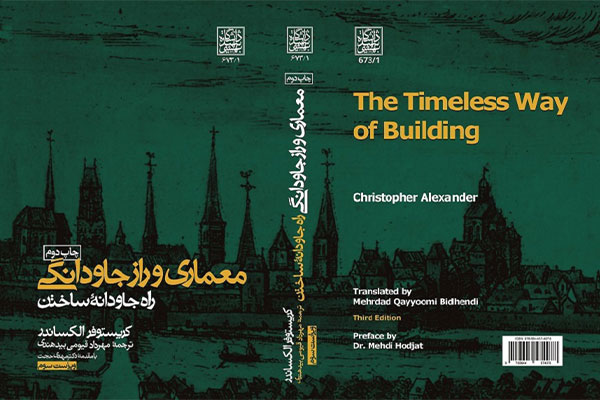
The Second Edition of "The Timeless Way of Building" (Third Edition) is Published.
The second edition of The Timeless Way of Building (Third Edition) by Christopher Alexander, translated by Dr. Mehrdad Ghayoumi Bidehendi, Associate Professor at the Faculty of Architecture and Urban Planning at Shahid Beheshti University, was published in 2024. This 494-page book, in medium octavo format, has been released by the university press and is available for 2,960,000 rials.
Few people are satisfied with the state of architecture and urban spaces in the contemporary world. Most individuals recognize that the majority of the environments they live in—whether homes, workplaces, streets, or alleys—are neither pleasant nor functional. At the same time, many people find traditional architectural spaces, created by architects or ordinary people before the modern era, far more enjoyable. This appreciation of traditional environments is not merely a result of nostalgia; historical studies have demonstrated that these spaces were both efficient and aesthetically pleasing for the people of their time. Moreover, it has been shown that traditional architecture and cities were more compatible with the natural environment, making them more sustainable and less harmful to the ecosystem. Why was architecture and urban planning so much more effective in an era without large architectural firms, construction companies, glossy design magazines, or academic architectural training?
Christopher Alexander (1936–2022), the distinguished Austrian-American architect and theorist, devoted his entire professional life to answering this question. He concluded that traditional architecture and urban spaces across cultures were built upon a language composed of timeless patterns that adapted to the needs of each era. These patterns consisted of specific functions and forms that created a pleasant and harmonious spatial quality—one that can be perceived but is difficult to define. This very quality is what modern environments often lack.
Through his writings, architectural projects, and educational and research activities, Alexander sought to demonstrate that the key to reviving contemporary architecture lies in reconstructing pattern languages—coherent systems that foster the creation of harmonious environments. The Timeless Way of Building is one of his most significant works, introducing the fundamental concepts necessary to understand this idea in the clearest and simplest terms. This book does not fit neatly into conventional categories of architectural theory or practical design manuals; rather, it occupies a unique position of its own.
The book is organized into four sections and 27 short chapters. Just as Alexander views a well-designed environment as a cohesive whole that must be considered in its entirety, he has structured this book as an integrated whole. To help readers grasp this overall vision even in limited time, he has highlighted the key sentences of each chapter in italics—allowing even those with only an hour to spare to gain a concise understanding of the book’s main ideas.
Students and enthusiasts can purchase the book by visiting the Scientific Publications Sales Office of Shahid Beheshti University, located on the ground floor of the IT Building. Additionally, online orders can be placed through the university's publication website. The electronic version of the book is also available for purchase on Fidibo and Taghche.


